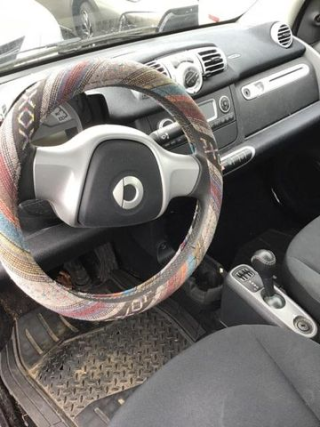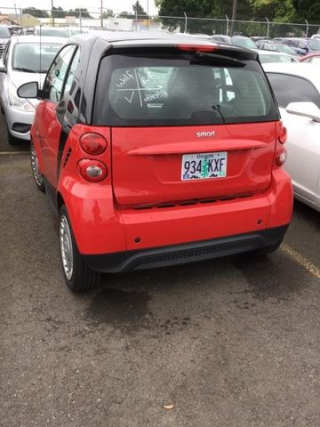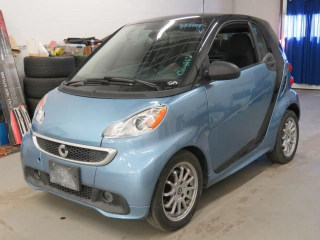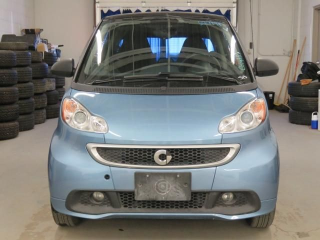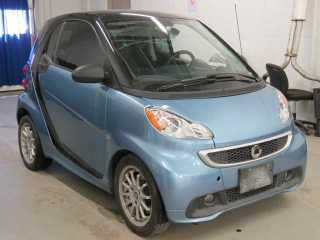The 2013 Smart fortwo is a two-door, two-seater microcar produced by Smart, a division of Daimler AG. Part of its second generation (C451, 2007-2015), it was available as a coupe or cabriolet, with "Pure" and "Passion" gasoline trims, plus an "Electric Drive" option. New prices ranged from about $12,500 to $28,000. It stands out for its incredibly compact size, making urban parking effortless and its unique, quirky design popular among city dwellers.
The Good
Its key advantages lie in unmatched urban maneuverability, effortless parking, and excellent fuel efficiency for gasoline models or zero emissions for the Electric Drive, appealing to practical buyers. Emotionally, its distinctive, cheerful design and "fun to drive" feel in city environments offer a unique and environmentally conscious ownership experience.
The Bad
Known weaknesses include its unrefined automated manual transmission, which can be jerky and slow, limited highway performance, a stiff and noisy ride, and minimal cargo space. Some interior plastics feel cheap, and it can suffer from higher-than-expected maintenance costs for its size, making it less appealing for long journeys.
2013 Smart fortwo: Quick Overview
- Engine Options:
- 1.0L I3 gasoline engine
- Electric motor (for Electric Drive model)
- Horsepower:
- Gasoline: 70 hp
- Electric Drive: 74 hp (peak)
- Fuel Economy:
- Gasoline: Approx. 34 MPG city / 38 MPG highway (EPA estimated)
- Electric Drive: 122 MPGe city / 93 MPGe highway (EPA estimated), offering a range of about 68 miles.
- 0-60 Times:
- Gasoline: Approx. 13-14 seconds (can feel slower due to transmission)
- Electric Drive: Approx. 11.5 seconds (quicker off the line)
- Towing Capacity: Not rated for towing.
- Trim-Level Features:
- Pure (Base Gasoline): Standard features include 15-inch steel wheels, manual windows and mirrors, a basic AM/FM CD audio system, central locking, power steering, and eight airbags. Air conditioning was often optional.
- Passion (Mid-range Gasoline): Adds 15-inch alloy wheels, a panoramic glass roof (coupe), power windows, power/heated mirrors, a leather-wrapped steering wheel, an enhanced audio system with auxiliary input, and automatic climate control. Options included heated seats and navigation.
- Electric Drive (Pure ED & Passion ED): Features an electric motor and battery pack, "Electric Drive" badging, and specific instrumentation for battery status and energy usage. It largely mirrors the Pure and Passion trim levels for convenience and comfort features, offering those respective amenities with the electric powertrain. Charging cable and port are standard.
2013 Smart fortwo Specifications
Vehicle Information
| Year | 2013 |
| Make | Smart |
| Model | fortwo |
| Trim | - |
| Style | - |
| Type | Coupe |
| Category | Sports Car |
Manufacturing Details
| Made In | Germany |
| Manufacturing City | HAMBACH |
Dimensions
| Doors | 2-Door |
| Curb Weight | 820.09 kg |
| Gross Vehicle Weight Rating | 1019.22 kg |
| Overall Height | 154.18 cm |
| Overall Length | 269.49 cm |
| Overall Width | 155.96 cm |
| Wheelbase Length | 186.69 cm |
| Standard Seating | 2 |
Engine & Performance
| Engine | 1.0-L L-3 DOHC 12V |
| Engine Size | 1L |
| Engine Cylinders | 3 |
| Transmission | 5-Speed Automatic |
| Transmission Type | Automatic |
| Transmission Speeds | 5-Speed |
| Drivetrain | Rear-Wheel Drive |
Additional Features
| Anti-Brake System | 4-Wheel ABS |
| Steering Type | Rack & Pinion |
Pricing
| Manufacturer Suggested Retail Price (MSRP) | $12,490 USD |
| Invoice Price | $11,616 USD |
| Delivery Charges | $750 USD |
Vehicle History Report
Vehicle
Specifications
Specifications
Ownership
History
History
All History
Events
Events
NMVTIS Title
History Check
History Check
Salvage/Rebuilt
Check
Check
Accident
Check
Check
Theft
Check
Check
Open Lien
Check
Check
Past Sale
Listings
Listings
Safety
Recalls
Recalls
Odometer
Check
Check
Market Price
Analysis
Analysis
What Problems Does the 2013 Smart fortwo Have?
The 2013 Smart Fortwo has several frequently reported problems and long-term reliability concerns, primarily centering around its unique engineering.
Transmission Issues: The automated manual transmission (AMT) is a common source of complaint. Owners frequently report jerky, slow shifts and an overall unrefined driving experience. While some issues are characteristic of the AMT design, reports of premature clutch wear and actuator problems are not uncommon, impacting perceived reliability and driving enjoyment.
Engine Mounts: Premature failure of engine mounts, especially in gasoline models, can lead to increased cabin vibration and noise as the vehicle ages. This is a fairly common wear item.
Electrical Gremlins: Minor electrical issues, such as faulty sensors (e.g., oxygen sensors), issues with interior lighting, or accessory functions, have been reported. While less common for the Electric Drive, battery degradation over time can reduce range, though catastrophic battery failures are rare.
Suspension Components: Due to its short wheelbase and stiff suspension, components like shocks, struts, and bushings can wear out more quickly, particularly if the vehicle is frequently driven on rough roads, leading to a harsher ride and increased noise.
Water Leaks: Some owners have reported issues with water ingress, often around door seals, windows, or sunroofs (if equipped), which can cause interior dampness and potentially lead to electrical problems.
Recalls for 2013 Smart Fortwo:
Transmission Issues: The automated manual transmission (AMT) is a common source of complaint. Owners frequently report jerky, slow shifts and an overall unrefined driving experience. While some issues are characteristic of the AMT design, reports of premature clutch wear and actuator problems are not uncommon, impacting perceived reliability and driving enjoyment.
Engine Mounts: Premature failure of engine mounts, especially in gasoline models, can lead to increased cabin vibration and noise as the vehicle ages. This is a fairly common wear item.
Electrical Gremlins: Minor electrical issues, such as faulty sensors (e.g., oxygen sensors), issues with interior lighting, or accessory functions, have been reported. While less common for the Electric Drive, battery degradation over time can reduce range, though catastrophic battery failures are rare.
Suspension Components: Due to its short wheelbase and stiff suspension, components like shocks, struts, and bushings can wear out more quickly, particularly if the vehicle is frequently driven on rough roads, leading to a harsher ride and increased noise.
Water Leaks: Some owners have reported issues with water ingress, often around door seals, windows, or sunroofs (if equipped), which can cause interior dampness and potentially lead to electrical problems.
Recalls for 2013 Smart Fortwo:
- NHTSA Recall 13V-233: This recall addressed a potential steering column failure in certain 2013 gasoline and Electric Drive models, which could lead to a loss of steering control. This was a significant safety concern requiring inspection and replacement of affected components.
- NHTSA Recall 13V-076: This recall involved a wiring harness defect that could prevent brake lights from illuminating, affecting a broader range of Smart Fortwo models, including 2013.
How long will the 2013 Smart fortwo last?
With diligent maintenance, a 2013 Smart Fortwo can reasonably achieve 100,000 to 150,000 miles, with some owners exceeding this, especially with primary city use. In terms of years, a lifespan of 10-15 years is attainable. Long-term durability is fair for its intended purpose as a city commuter. However, specific weaknesses emerge over time. The automated manual transmission, if not correctly maintained or if driven aggressively, can develop rougher shifts, clutch wear, or actuator issues. Suspension components like shocks and bushings are prone to wear, impacting ride quality. Minor electrical issues can surface, and interior plastics may show significant wear. For Electric Drive models, battery capacity degradation leading to reduced range is the main long-term concern, though the powertrain itself is often reliable. Regular fluid changes, timely service, and addressing wear-and-tear items are crucial for maximizing its operational life.
What Technology & Safety Features are Included?
The 2013 Smart Fortwo, true to its microcar nature, featured a functional but not lavish array of technology and safety features.
Built-in Tech & Entertainment:
Modern driver-assistance technologies like adaptive cruise control, lane-keeping assist, or blind-spot monitoring were not available on the 2013 Smart Fortwo, as its design emphasized fundamental safety within a compact footprint.
Safety Features:
Despite its diminutive size, the Smart Fortwo was engineered with significant safety in mind, notably featuring a high-strength "tridion safety cell."
Built-in Tech & Entertainment:
- Standard: The Pure trim came with a basic AM/FM radio, CD player, and two speakers. Air conditioning was either standard or a widely available option.
- Passion Trim & Options: The Passion trim elevated the experience with an upgraded audio system, often including an auxiliary input. Bluetooth connectivity was an optional extra, as was a basic integrated navigation system. Power windows, power/heated mirrors, and automatic climate control were standard on the Passion.
- Electric Drive Specifics: Electric Drive models featured unique digital instrumentation to display crucial information like battery charge, estimated range, and real-time energy consumption, distinguishing them from their gasoline counterparts.
Modern driver-assistance technologies like adaptive cruise control, lane-keeping assist, or blind-spot monitoring were not available on the 2013 Smart Fortwo, as its design emphasized fundamental safety within a compact footprint.
Safety Features:
Despite its diminutive size, the Smart Fortwo was engineered with significant safety in mind, notably featuring a high-strength "tridion safety cell."
- Standard Safety: All models included eight airbags (dual front, driver and passenger knee, and side curtain), an Electronic Stability Program (ESP), Anti-lock Braking System (ABS), Traction Control System (TCS), and Hill Start Assist.
- IIHS (Insurance Institute for Highway Safety): The 2013 Fortwo received "Good" ratings in moderate overlap front, side impact, and roof strength tests. However, it earned a "Poor" rating in the small overlap front test, indicating limited protection in that specific crash scenario.
- NHTSA (National Highway Traffic Safety Administration): It achieved an overall safety rating of 4 out of 5 stars. Specific ratings included 4 stars for frontal crash, 5 stars for side crash, and 4 stars for rollover resistance, demonstrating a generally good level of protection for its class.
What Colors Options are Available?
2013 Smart fortwo Prices and Market Value
When new in 2013, the Smart Fortwo gasoline models started around $12,490 for the Pure Coupe and went up to about $17,690 for the Passion Cabriolet. The Electric Drive models were considerably more expensive, beginning at approximately $25,750 for the Pure ED Coupe, prior to any federal or state incentives.
Today, used market prices for a 2013 model are significantly lower, typically ranging from $3,000 to $7,000 for gasoline versions and $4,000 to $9,000 for Electric Drive models, heavily dependent on condition and battery health. The Smart Fortwo has experienced substantial depreciation. This is due to its niche appeal, the polarizing automated manual transmission, limited practicality for most buyers, and the availability of newer, more refined small cars. Electric Drive models further face concerns about battery degradation, which impacts their long-term value. Factors like high mileage, lack of service records, and visible wear can further depress resale value.
Today, used market prices for a 2013 model are significantly lower, typically ranging from $3,000 to $7,000 for gasoline versions and $4,000 to $9,000 for Electric Drive models, heavily dependent on condition and battery health. The Smart Fortwo has experienced substantial depreciation. This is due to its niche appeal, the polarizing automated manual transmission, limited practicality for most buyers, and the availability of newer, more refined small cars. Electric Drive models further face concerns about battery degradation, which impacts their long-term value. Factors like high mileage, lack of service records, and visible wear can further depress resale value.
2013 Smart fortwo Cost of Ownership
The 2013 Smart Fortwo presents a mixed ownership cost profile. Insurance premiums are generally low, thanks to its modest power and purchase price. Fuel costs for the gasoline model are very economical due to excellent MPG, while Electric Drive models boast extremely low "fuel" costs based on electricity rates. Routine maintenance is reasonably priced. However, repairs, particularly for the automated manual transmission or specialized components, can be surprisingly expensive for such a small car, potentially offsetting fuel savings. Its small size can sometimes lead to slightly higher parts costs if specialists are required. Overall, it's moderately economical to own, primarily due to its fuel efficiency, but potential unexpected repair bills for specific issues can make it less "cheap" than its size might suggest.
2013 Smart fortwo Fuel Efficiency
Fuel Type
Gasoline
Fuel Capacity
32.93 liters
City Mileage
14.03 km/l
Highway Mileage
17.43 km/l
2013 Smart fortwo Safety Rating
NHTSA
IIHS
2013 Smart fortwo Warranty
Basic
Original warranty
48 months / 50,000 miles
Estimated remaining
Expired
Powertrain
Original warranty
48 months / 50,000 miles
Estimated remaining
Expired
Rust
Original warranty
48 months / 50,000 miles
Estimated remaining
Expired
2013 Smart fortwo Insurance
Insurance for a 2013 Smart fortwo is moderately priced, reflecting its status as a Coupe with strong safety ratings and
reasonable repair costs.
reasonable repair costs.
How Does the 2013 Smart fortwo Compare to Other Coupe?
The 2013 Smart Fortwo operates in a unique microcar segment, making direct competition scarce, but it often cross-shopped with subcompacts.
Performance: The Fortwo's performance is strictly city-focused, with its 70-74 hp engine providing adequate urban acceleration but struggling significantly on highways. Its automated manual transmission (AMT) is widely criticized for slow, jerky shifts.
Performance: The Fortwo's performance is strictly city-focused, with its 70-74 hp engine providing adequate urban acceleration but struggling significantly on highways. Its automated manual transmission (AMT) is widely criticized for slow, jerky shifts.
- Rivals: The Fiat 500, Scion iQ, and even the Chevrolet Spark offered more refined driving dynamics. The Fiat 500, especially with a manual or conventional automatic, provided a smoother experience and better highway capability. The Scion iQ, while similarly small, had a more conventional CVT.
- Rivals: The Fiat 500 offered more stylish interiors and optional upscale features. The Chevrolet Spark typically came with a more contemporary infotainment system. Even the Scion iQ, while also minimalist, offered a slightly more robust standard feature set.
- Rivals: Japanese alternatives like the Scion iQ or a slightly larger Honda Fit generally boast superior long-term reliability records. The Fiat 500's reliability was often comparable or only marginally better than the Smart's, with its own set of electrical and transmission complaints.
- Rivals: The Fiat 500 held its value slightly better. The Chevrolet Spark and Mitsubishi Mirage (post-2013) offered more space and traditional automatics for similar or less money, especially on the used market. The Scion iQ, priced similarly to the Smart new, also depreciated heavily, making it a direct used alternative.
Final Verdict: Is the 2013 Smart fortwo a Good Coupe?
The 2013 Smart Fortwo is an excellent niche vehicle, ideal for singles or couples residing in dense urban environments where parking is a critical challenge. Its unparalleled maneuverability and incredibly small footprint make it perfect for city commuting. It also appeals to eco-conscious buyers, particularly the Electric Drive model, for its zero-emission capability.
As a used purchase, it can be worth buying, but with specific caveats. Its significant depreciation makes it an affordable second car for purely urban trips. Buyers must be aware of its limitations: the unrefined automated manual transmission, stiff ride, minimal cargo capacity, and poor highway performance. Opting for a "Passion" trim offers better comfort. The Electric Drive is great for predictable, short-range commutes if its battery health is confirmed. It is not suitable as a primary family vehicle or for frequent highway travel. This vehicle is best for those with realistic expectations, seeking a specialized, unique, and highly practical city-specific solution.
As a used purchase, it can be worth buying, but with specific caveats. Its significant depreciation makes it an affordable second car for purely urban trips. Buyers must be aware of its limitations: the unrefined automated manual transmission, stiff ride, minimal cargo capacity, and poor highway performance. Opting for a "Passion" trim offers better comfort. The Electric Drive is great for predictable, short-range commutes if its battery health is confirmed. It is not suitable as a primary family vehicle or for frequent highway travel. This vehicle is best for those with realistic expectations, seeking a specialized, unique, and highly practical city-specific solution.
